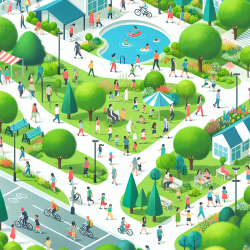Introduction
As speech-language pathologists, we are committed to fostering environments that promote the well-being of children and their communities. Recent research has highlighted the significant impact of neighborhood walkability on health-related quality of life (HR-QoL), especially in minoritized populations. This blog explores how practitioners can leverage these insights to improve community health outcomes.
Understanding the Research
The study, "Perceived neighborhood environment walkability and health-related quality of life among predominantly Black and Latino adults in New York City," examines the relationship between perceived neighborhood walkability and HR-QoL. The research utilized data from 1,252 residents, predominantly Black and Latino, in New York City. The study identified two key subscales of neighborhood walkability: enablers (e.g., trails, sidewalks, aesthetics) and barriers (e.g., high crime and traffic).
Key Findings
The research revealed that mental HR-QoL was negatively impacted by barriers to walkability and positively associated with neighborhood satisfaction. Conversely, physical HR-QoL was only associated with barriers to walkability. These findings suggest that addressing negative aspects of the neighborhood environment may be more crucial than adding positive features in improving HR-QoL.
Implications for Practitioners
Practitioners can take several steps to apply these findings in their work:
- Advocate for Safe Environments: Collaborate with urban planners and community leaders to address barriers such as crime and traffic, which negatively impact HR-QoL.
- Promote Community Engagement: Encourage community involvement in neighborhood planning to enhance satisfaction and mental well-being.
- Conduct Further Research: Engage in research to explore the specific needs of minoritized communities and develop targeted interventions.
Encouraging Further Research
While this study provides valuable insights, it also highlights the need for further research into the role of the built environment in urban, minoritized communities. Practitioners are encouraged to explore these areas to develop more effective strategies for improving community health outcomes.
To read the original research paper, please follow this link: Perceived neighborhood environment walkability and health-related quality of life among predominantly Black and Latino adults in New York City.










